A Comprehensive Study on the Factors Affecting the Workability and Mechanical Properties of Ambient Cured Fly Ash and Slag Based Geopolymer Concrete
Abstract
:1. Introduction
2. Experimental Program
2.1. Materials Specifications
2.2. Mix Proportions
2.3. Preparation of Specimens
2.4. Testing Procedures
3. Results and Discussions
3.1. Workability
3.1.1. Influence of Slag Content
3.1.2. Influence of Molarity of NaOH Solution
3.1.3. Influence of AAS Content
3.1.4. Influence of SS/SH Ratio
3.1.5. Influence of Extra Water
3.2. Compressive Strength
3.2.1. Influence of Slag Content
3.2.2. Influence of Molarity of NaOH Solution
3.2.3. Influence of AAS Content
3.2.4. Influence of SS/SH Ratio
3.2.5. Influence of Extra Water
3.3. Tensile Strength
3.4. Flexural Strength
3.5. Elastic Modulus
4. Concluding Remarks
- Increasing the slag replacement levels and decreasing the alkaline activator content resulted in a reduction of workability for all FS-GPC mixes. The slag contents have substantial influence on the slump values at higher molarity of NaOH solution M = 14, lower AAS content (35%), and lower value of SS/SH ration (2.0). The workability of FS-GPC mixes was also decreased by increasing the molarity (10 M to 12 M and 14 M) of NaOH solution. The influence of NaOH solution concentration was more noticeable for the mixes with higher slag content. Increasing the sodium silicate content (SS/SH = 2.0 to 2.5 or 3.0) in AAS also led to a decrease in workability of the mix. The additional water can be used to enhance the workability of FS-GPC mixes in situations where high workable (100 mm to 150 mm) concrete mixes are desired, keeping in view the strength requirements.
- The increase in the slag contents from 10% to 50% resulted in an increase in the compressive strength for the mixes at a rapid rate till the age of 28 days, after which the rate of development of strength slowed down. The compressive strength of FS-GPC mixes was also increased by increasing the molarity (10 M to 12 M, and 14 M) of NaOH solution and lowering the AAS content to 35%. The influence of amount of alkaline activator seems to be more pronounced at lower levels of slag contents. The influence of alkaline activator was more noticeable at early age of GPC mixes, i.e., 7 to 14 days, with little or no effect at 90 days strength. The mixes showed increase in compressive strength by increasing SS/SH ratio from 2.0 to 2.5, whereas beyond 2.5 it decreased. The strength of FS-GPC mixes decreased with the addition of extra water (excluding that used for preparing AAS).
- The practicable mix for FS-GPC, with slump value in the range of 60–100 mm and 28 days compressive strength values in the range of 30–50 MPa, suitable for various concreting applications, i.e., columns, beams, and foundations, can be obtained by limiting the slag content to 20% or 30%, SS/SH ratio to 2.0 or 2.5, molarity of NaOH solution to 10 M or 12 M, and alkaline content to 40%.
- The tensile and flexural strength of FS-GPC mixes showed similar trends to that of the compressive strength. The tensile and flexural strength of FS-GPC increased by increasing the slag replacement levels, molarity of NaOH solution, and SS/SH ratio (2.0 to 2.5) and decreasing the alkaline activator content (40% to 35%). The influence of slag content, molarity of NaOH solution, and AAS content on the elastic modulus of FS-GPC mixes was also similar to that of the compressive strength. However, the influence of SS/SH ratio on the static modulus was different than the compressive strength. Increasing the SS/SH ratio from 2.0 to 2.5 had no effect on the elastic modulus, while a decrease was observed when it was increased from 2.5 to 3.0.
- The expressions provided by Diaz-Loya et al. and Nath and Sarkar have overestimated the values of flexural strength as compared to the present study. The values of tensile strength predicted by Sofi et al. were much higher than the experimentally measured values of this study. The values of elastic modulus predicted by Diaz-Loya et al. were higher, whereas those predicted by Lee and Lee were much lower than the present study. From the test results of the present study, Equations (6), (11), and (17) are proposed to predict the tensile strength, flexural strength, and static modulus of ambient cured FS-GPC mixes, respectively. The schematic illustration of the proposed relationship is shown in Figure 21.
- The study proposed empirical equations which are valid for ambient cured FS-GPC mixes with slag contents 10% to 50% of total binder; AAS content 35% to 40% of total binder; molarity of NaOH solution 10 M to 14 M, and SS/SH ratio 2.0 to 3.0. These equations can be used to provide prediction of tensile strength, flexural strength, and modulus of elasticity of FS-GPC mixes with 28 days compressive strengths in the range of 30–60 MPa.
Author Contributions
Funding
Conflicts of Interest
References
- Zahid, M.; Shafiq, N.; Isa, M.H.; Gil, L. Statistical modeling and mix design optimization of fly ash based engineered geopolymer composite using response surface methodology. J. Clean. Prod. 2018, 194, 483–498. [Google Scholar] [CrossRef]
- Reddy, M.S.; Dinakar, P.; Rao, B.H. Mix design development of fly ash and ground granulated blast furnace slag based geopolymer concrete. J. Build. Eng. 2018, 20, 712–722. [Google Scholar] [CrossRef]
- Chalid, A. Effect of the Ground Granulated Blast Furnaceslag on the Pore Structure of Concrete. Arch. Civ. Eng. 2021, LXVII, 203–214. [Google Scholar]
- Jin, S.; Zhao, Z.; Jiang, S.; Sun, J.; Pan, H.; Jiang, L. Comparison and Summary of Relevant Standards for Comprehensive Utilization of Fly Ash at Home and Abroad. IOP Conf. Ser. Earth Environ. Sci. 2021, 621, 012006. [Google Scholar] [CrossRef]
- Sisol, M.; Drabová, M.; Mosej, J. Alkali activation of fresh and deposited black coal fly ash with high loss on ignition. Gospod. Surowcami Miner.-Miner. Resour. Manag. 2014, 30, 1–13. [Google Scholar] [CrossRef] [Green Version]
- Guo, J.; Bao, Y.; Wang, M. Steel slag in China: Treatment, recycling, and management. Waste Manag. 2018, 78, 318–330. [Google Scholar] [CrossRef]
- McLellan, B.C.; Williams, R.P.; Lay, J.; Van Riessen, A.; Corder, G.D. Costs and carbon emissions for geopolymer pastes in comparison to ordinary portland cement. J. Clean. Prod. 2011, 19, 1080–1090. [Google Scholar] [CrossRef] [Green Version]
- Turner, L.K.; Collins, F.G. Carbon dioxide equivalent (CO2-e) emissions: A comparison between geopolymer and OPC cement concrete. Constr. Build. Mater. 2013, 43, 125–130. [Google Scholar] [CrossRef]
- Saravanakumar, R.; Revathi, V. Some durability aspects of ambient cured bottom ash geopolymer concrete. Arch. Civ. Eng. 2017, 63, 99–114. [Google Scholar] [CrossRef]
- Waqas, R.M.; Butt, F. Behavior of Quarry Rock Dust, Fly Ash and Slag Based Geopolymer Concrete Columns Reinforced with Steel Fibers under Eccentric Loading. Appl. Sci. 2021, 11, 6740. [Google Scholar] [CrossRef]
- Zhu, H.; Yang, S.; Li, W.; Li, Z.; Fan, J.; Shen, Z. Study of Mechanical Properties and Durability of Alkali-Activated Coal Gangue-Slag Concrete. Materials 2020, 13, 5576. [Google Scholar] [CrossRef]
- Meshram, R.; Kumar, S. Comparative life cycle assessment (LCA) of geopolymer cement manufacturing with Portland cement in Indian context. Int. J. Environ. Sci. Technol. 2021, 2, 1–12. [Google Scholar] [CrossRef]
- Duxson, P.; Fernández-Jiménez, A.; Provis, J.L.; Lukey, G.C.; Palomo, A.; van Deventer, J.S. Geopolymer technology: The current state of the art. J. Mater. Sci. 2007, 42, 2917–2933. [Google Scholar] [CrossRef]
- Yang, K.-H.; Song, J.-K.; Song, K.-I. Assessment of CO2 reduction of alkali-activated concrete. J. Clean. Prod. 2013, 39, 265–272. [Google Scholar] [CrossRef]
- Zhuang, X.Y.; Chen, L.; Komarneni, S.; Zhou, C.H.; Tong, D.S.; Yang, H.M.; Yu, W.H.; Wang, H. Fly ash-based geopolymer: Clean production, properties and applications. J. Clean. Prod. 2016, 125, 253–267. [Google Scholar] [CrossRef]
- Chen, L.; Wang, Z.; Wang, Y.; Feng, J. Preparation and Properties of Alkali Activated Metakaolin-Based Geopolymer. Materials 2016, 9, 767. [Google Scholar] [CrossRef] [Green Version]
- Habert, G.; De Lacaillerie, J.D.E.; Roussel, N. An environmental evaluation of geopolymer based concrete production: Reviewing current research trends. J. Clean. Prod. 2011, 19, 1229–1238. [Google Scholar] [CrossRef]
- Slaty, F.; Khoury, H.; Wastiels, J.; Rahier, H. Characterization of alkali activated kaolinitic clay. Appl. Clay Sci. 2013, 75, 120–125. [Google Scholar] [CrossRef]
- Noushini, A.; Aslani, F.; Castel, A.; Gilbert, R.I.; Uy, B.; Foster, S. Compressive stress-strain model for low-calcium fly ash-based geopolymer and heat-cured Portland cement concrete. Cem. Concr. Compos. 2016, 73, 136–146. [Google Scholar] [CrossRef]
- Parveen, A.S.; Singhal, D. Mechanical properties of geopolymer concrete: A state of the art report. In Proceedings of the 5th Asia and Pacific Young Researchers and Graduate Symposium, Jaipur, India, 29–30 August 2013. [Google Scholar]
- Wallah, S.; Rangan, B.V. Low-Calcium Fly Ash-Based Geopolymer Concrete: Long-Term Properties; Curtin University of Technology: Bentley, Australia, 2006. [Google Scholar]
- Yip, C.K.; Lukey, G.; Van Deventer, J.S. The coexistence of geopolymeric gel and calcium silicate hydrate at the early stage of alkaline activation. Cem. Concr. Res. 2005, 35, 1688–1697. [Google Scholar] [CrossRef]
- Okoye, F.; Durgaprasad, J.; Singh, N. Mechanical properties of alkali activated flyash/Kaolin based geopolymer concrete. Constr. Build. Mater. 2015, 98, 685–691. [Google Scholar] [CrossRef]
- Lee, W.-H.; Lin, K.-L.; Chang, T.-H.; Ding, Y.-C.; Cheng, T.-W. Sustainable Development and Performance Evaluation of Marble-Waste-Based Geopolymer Concrete. Polymers 2020, 12, 1924. [Google Scholar] [CrossRef] [PubMed]
- Hadi, M.N.; Zhang, H.; Parkinson, S. Optimum mix design of geopolymer pastes and concretes cured in ambient condition based on compressive strength, setting time and workability. J. Build. Eng. 2019, 23, 301–313. [Google Scholar] [CrossRef]
- Aliabdo, A.A.; Abd Elmoaty, M.; Emam, M.A. Factors affecting the mechanical properties of alkali activated ground granulated blast furnace slag concrete. Constr. Build. Mater. 2019, 197, 339–355. [Google Scholar] [CrossRef]
- Bellum, R.R.; Nerella, R.; Madduru, S.R.C.; Indukuri, C.S.R. Mix design and mechanical properties of fly ash and GGBFS-synthesized alkali-activated concrete (AAC). Infrastructures 2019, 4, 20. [Google Scholar] [CrossRef] [Green Version]
- Deb, P.S.; Nath, P.; Sarker, P.K. The effects of ground granulated blast-furnace slag blending with fly ash and activator content on the workability and strength properties of geopolymer concrete cured at ambient temperature. Mater. Des. 2014, 62, 32–39. [Google Scholar] [CrossRef] [Green Version]
- Ding, Y.; Dai, J.-G.; Shi, C.-J. Mechanical properties of alkali-activated concrete: A state-of-the-art review. Constr. Build. Mater. 2016, 127, 68–79. [Google Scholar] [CrossRef] [Green Version]
- Lee, N.; Lee, H.-K. Setting and mechanical properties of alkali-activated fly ash/slag concrete manufactured at room temperature. Constr. Build. Mater. 2013, 47, 1201–1209. [Google Scholar] [CrossRef]
- Nath, P.; Sarker, P.K. Effect of GGBFS on setting, workability and early strength properties of fly ash geopolymer concrete cured in ambient condition. Constr. Build. Mater. 2014, 66, 163–171. [Google Scholar] [CrossRef] [Green Version]
- Pavithra, P.; Reddy, M.S.; Dinakar, P.; Rao, B.H.; Satpathy, B.; Mohanty, A. A mix design procedure for geopolymer concrete with fly ash. J. Clean. Prod. 2016, 133, 117–125. [Google Scholar] [CrossRef]
- Wang, W.-C.; Wang, H.-Y.; Lo, M.-H. The fresh and engineering properties of alkali activated slag as a function of fly ash replacement and alkali concentration. Constr. Build. Mater. 2015, 84, 224–229. [Google Scholar] [CrossRef]
- Fang, G.; Ho, W.K.; Tu, W.; Zhang, M. Workability and mechanical properties of alkali-activated fly ash-slag concrete cured at ambient temperature. Constr. Build. Mater. 2018, 172, 476–487. [Google Scholar] [CrossRef]
- Memon, F.A.; Nuruddin, M.F.; Khan, S.; Shafiq, N.; Ayub, T. Effect of sodium hydroxide concentration on fresh properties and compressive strength of self-compacting geopolymer concrete. J. Eng. Sci. Technol. 2013, 8, 44–56. [Google Scholar]
- Nath, P.; Sarker, P.K.; Rangan, V.B. Early age properties of low-calcium fly ash geopolymer concrete suitable for ambient curing. Procedia Eng. 2015, 125, 601–607. [Google Scholar] [CrossRef] [Green Version]
- Yip, C.K.; Lukey, G.C.; Provis, J.L.; Van Deventer, J.S. Effect of calcium silicate sources on geopolymerisation. Cem. Concr. Res. 2008, 38, 554–564. [Google Scholar] [CrossRef]
- Kumar, S.; Kumar, R.; Mehrotra, S. Influence of granulated blast furnace slag on the reaction, structure and properties of fly ash based geopolymer. J. Mater. Sci. 2010, 45, 607–615. [Google Scholar] [CrossRef]
- Wan, X.; Hou, D.; Zhao, T.; Wang, L. Insights on molecular structure and micro-properties of alkali-activated slag materials: A reactive molecular dynamics study. Constr. Build. Mater. 2017, 139, 430–437. [Google Scholar] [CrossRef]
- Arioz, E.; Arioz, O.; Kockar, O.M. An experimental study on the mechanical and microstructural properties of geopolymers. Procedia Eng. 2012, 42, 100–105. [Google Scholar] [CrossRef] [Green Version]
- Rafeet, A.; Vinai, R.; Soutsos, M.; Sha, W. Guidelines for mix proportioning of fly ash/GGBS based alkali activated concretes. Constr. Build. Mater. 2017, 147, 130–142. [Google Scholar] [CrossRef] [Green Version]
- Ryu, G.S.; Lee, Y.B.; Koh, K.T.; Chung, Y.S. The mechanical properties of fly ash-based geopolymer concrete with alkaline activators. Constr. Build. Mater. 2013, 47, 409–418. [Google Scholar] [CrossRef]
- Joseph, B.; Mathew, G. Influence of aggregate content on the behavior of fly ash based geopolymer concrete. Sci. Iran. 2012, 19, 1188–1194. [Google Scholar] [CrossRef] [Green Version]
- Weng, L.; Sagoe-Crentsil, K. Dissolution processes, hydrolysis and condensation reactions during geopolymer synthesis: Part I—Low Si/Al ratio systems. J. Mater. Sci. 2007, 42, 2997–3006. [Google Scholar] [CrossRef]
- Singhal, D.; Junaid, M.T.; Jindal, B.B.; Mehta, A. Mechanical and microstructural properties of fly ash based geopolymer concrete incorporating alccofine at ambient curing. Constr. Build. Mater. 2018, 180, 298–307. [Google Scholar]
- Sofi, M.; Van Deventer, J.; Mendis, P.; Lukey, G. Engineering properties of inorganic polymer concretes (IPCs). Cem. Concr. Res. 2007, 37, 251–257. [Google Scholar] [CrossRef]
- Diaz-Loya, E.I.; Allouche, E.N.; Vaidya, S. Mechanical properties of fly-ash-based geopolymer concrete. ACI Mater. J. 2011, 108, 300. [Google Scholar]
- Nath, P.; Sarker, P.K. Flexural strength and elastic modulus of ambient-cured blended low-calcium fly ash geopolymer concrete. Constr. Build. Mater. 2017, 130, 22–31. [Google Scholar] [CrossRef] [Green Version]
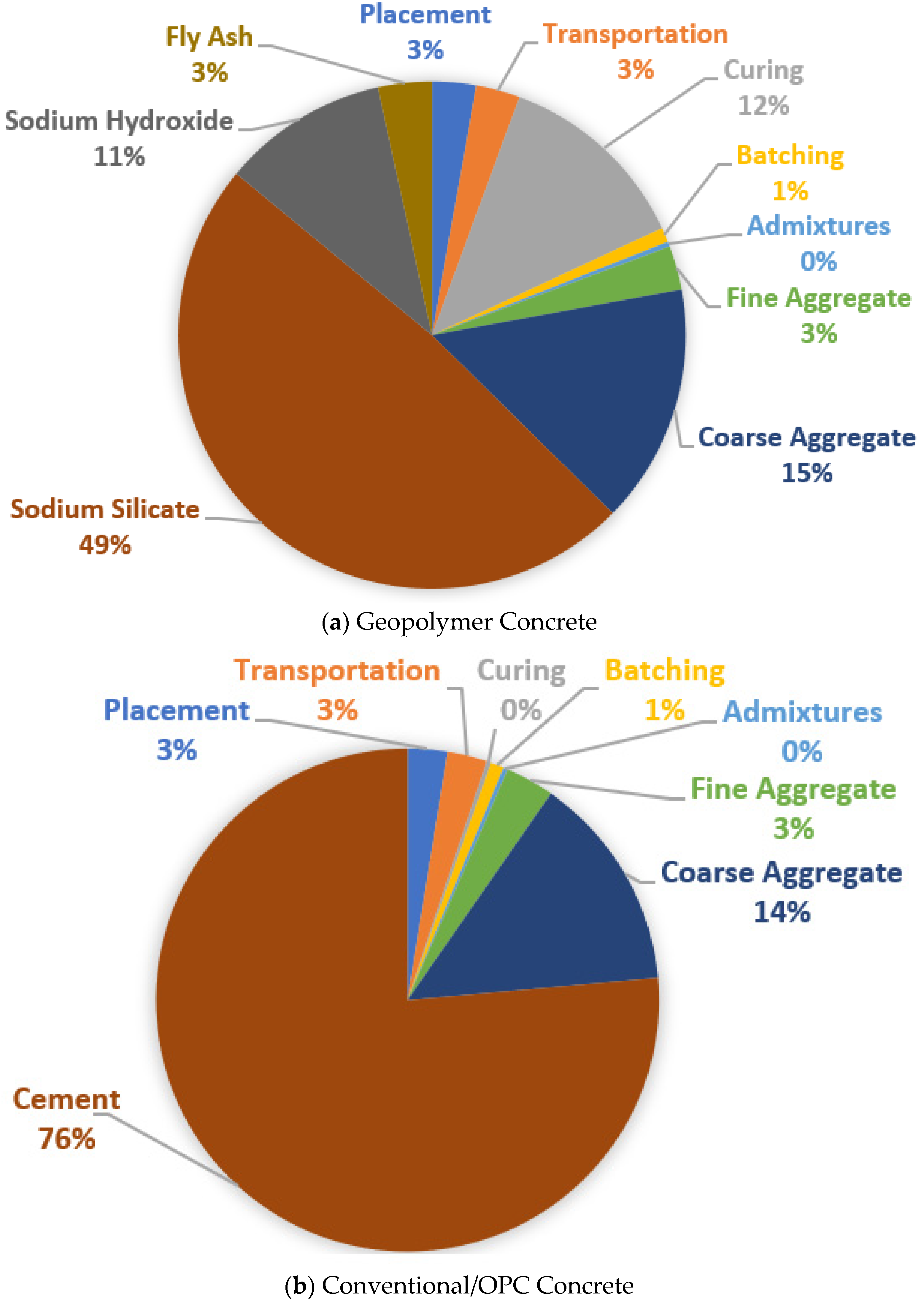
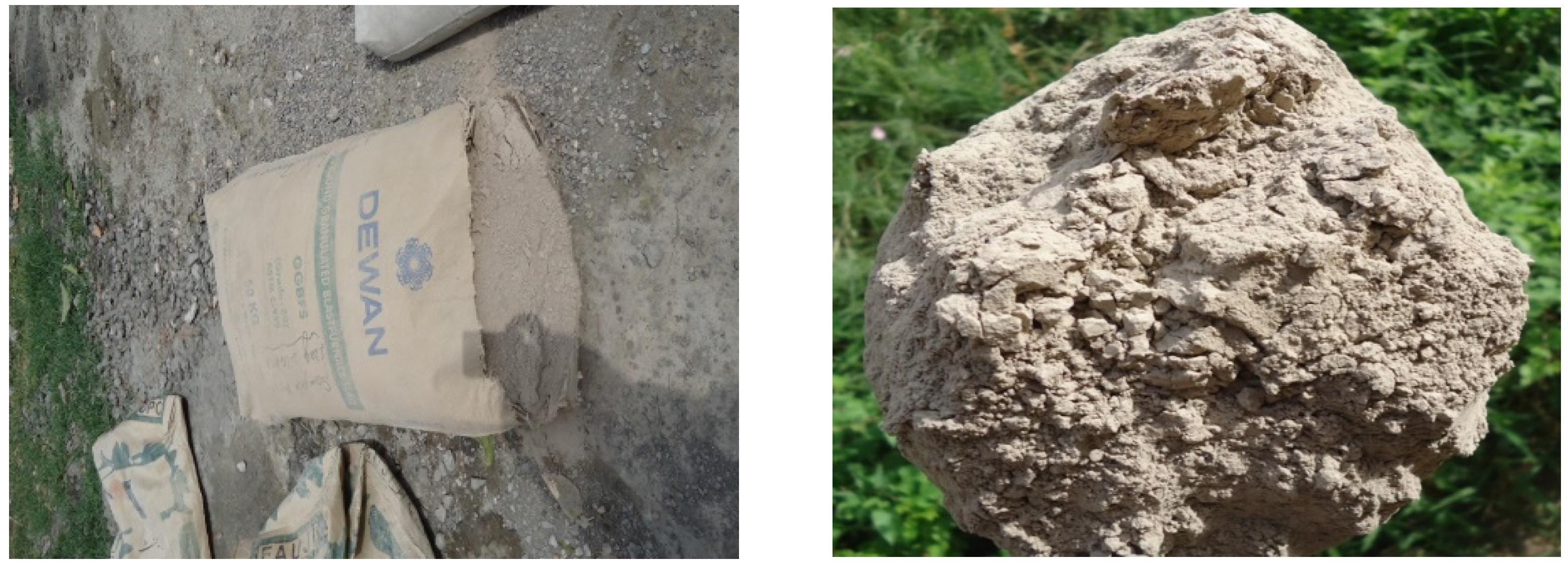
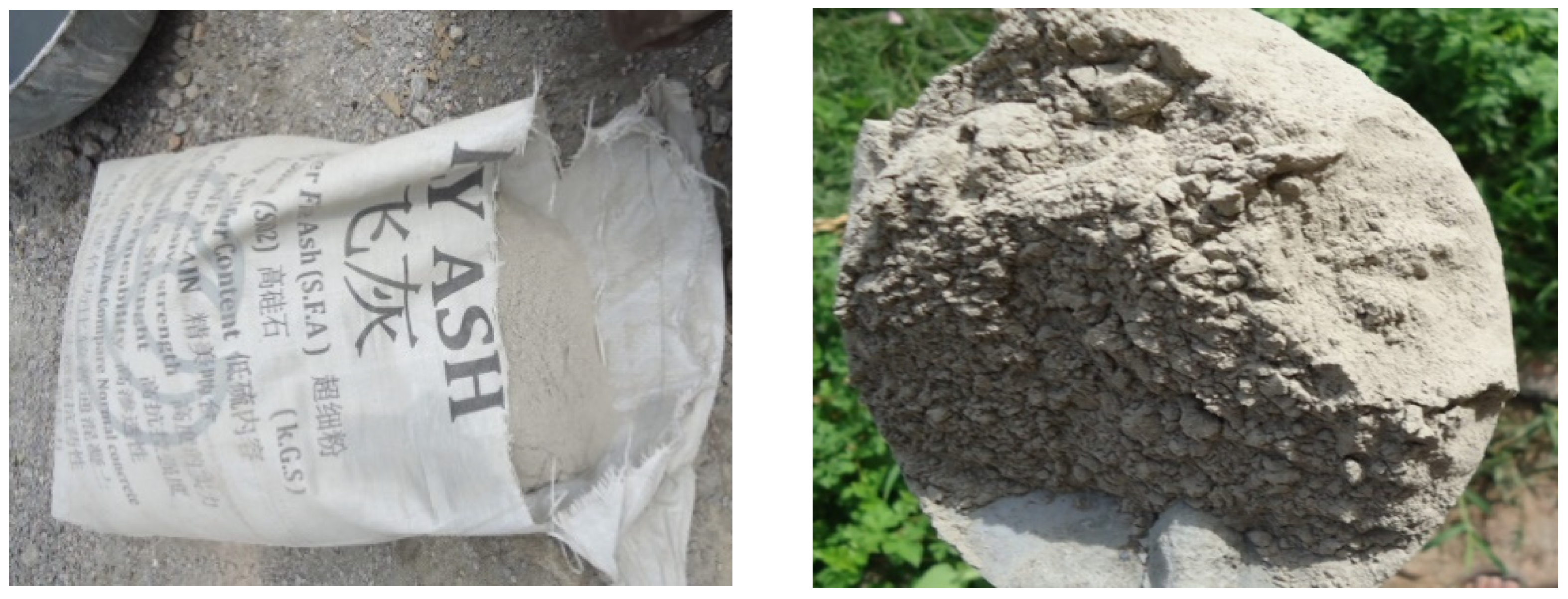

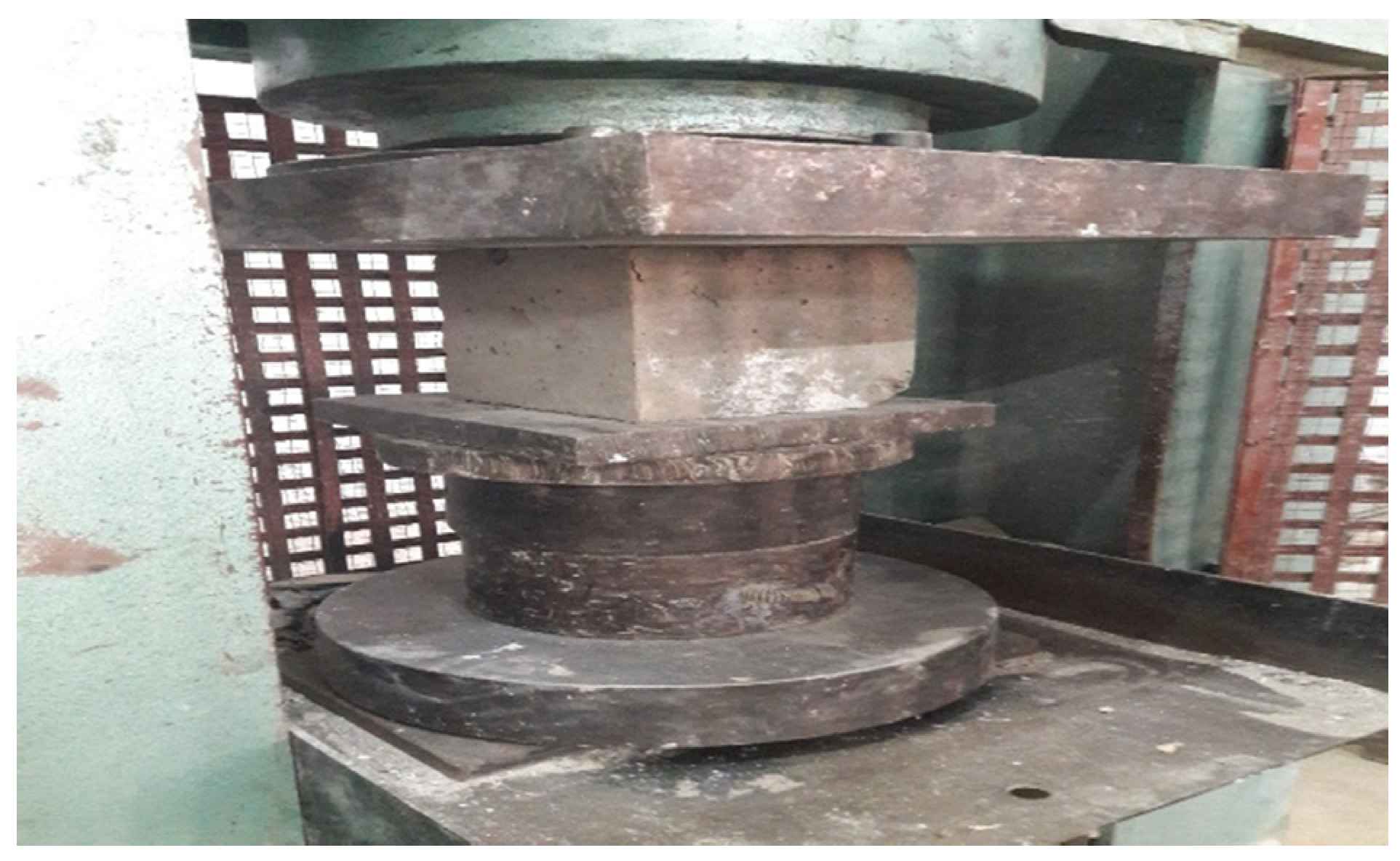
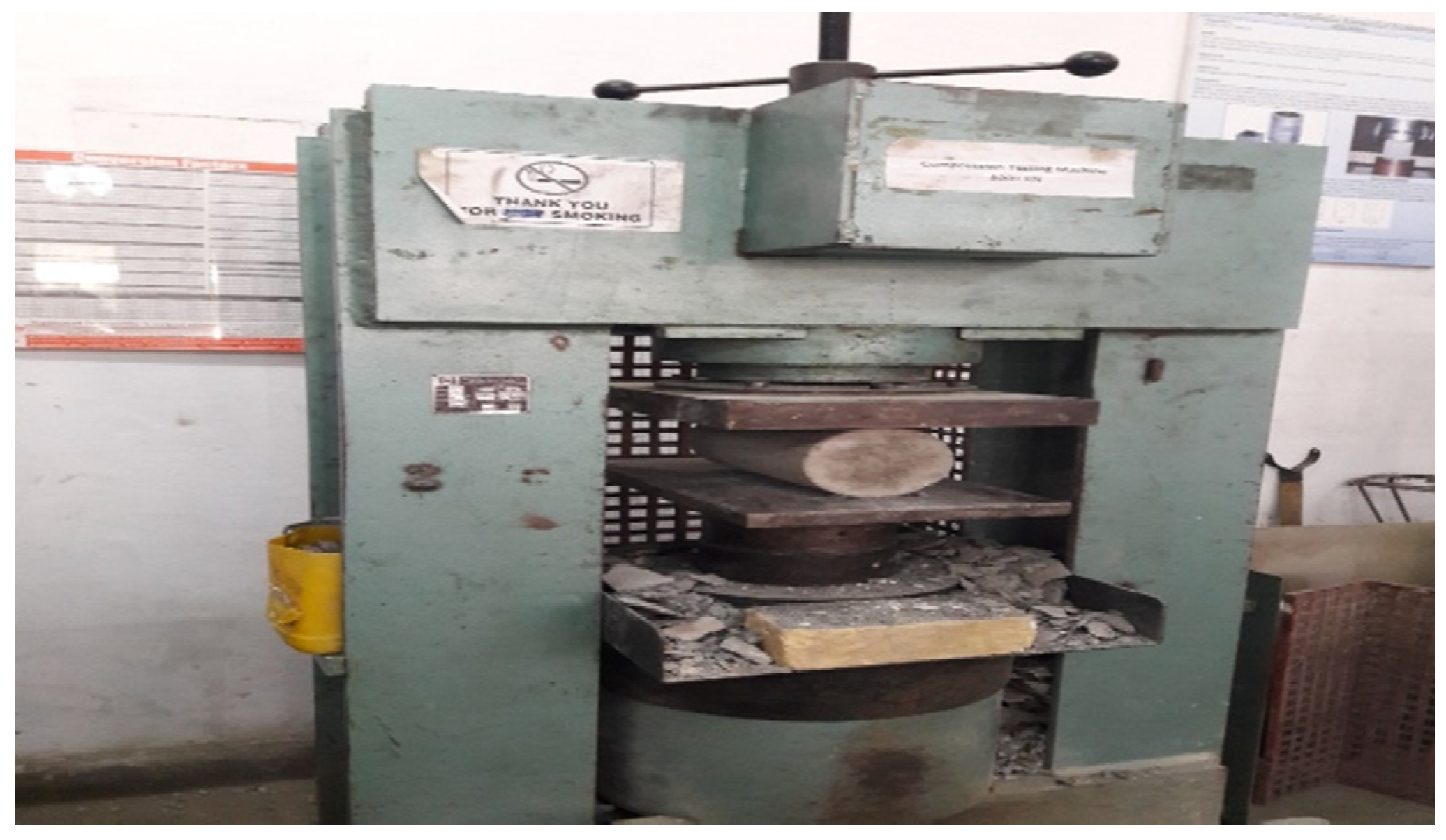
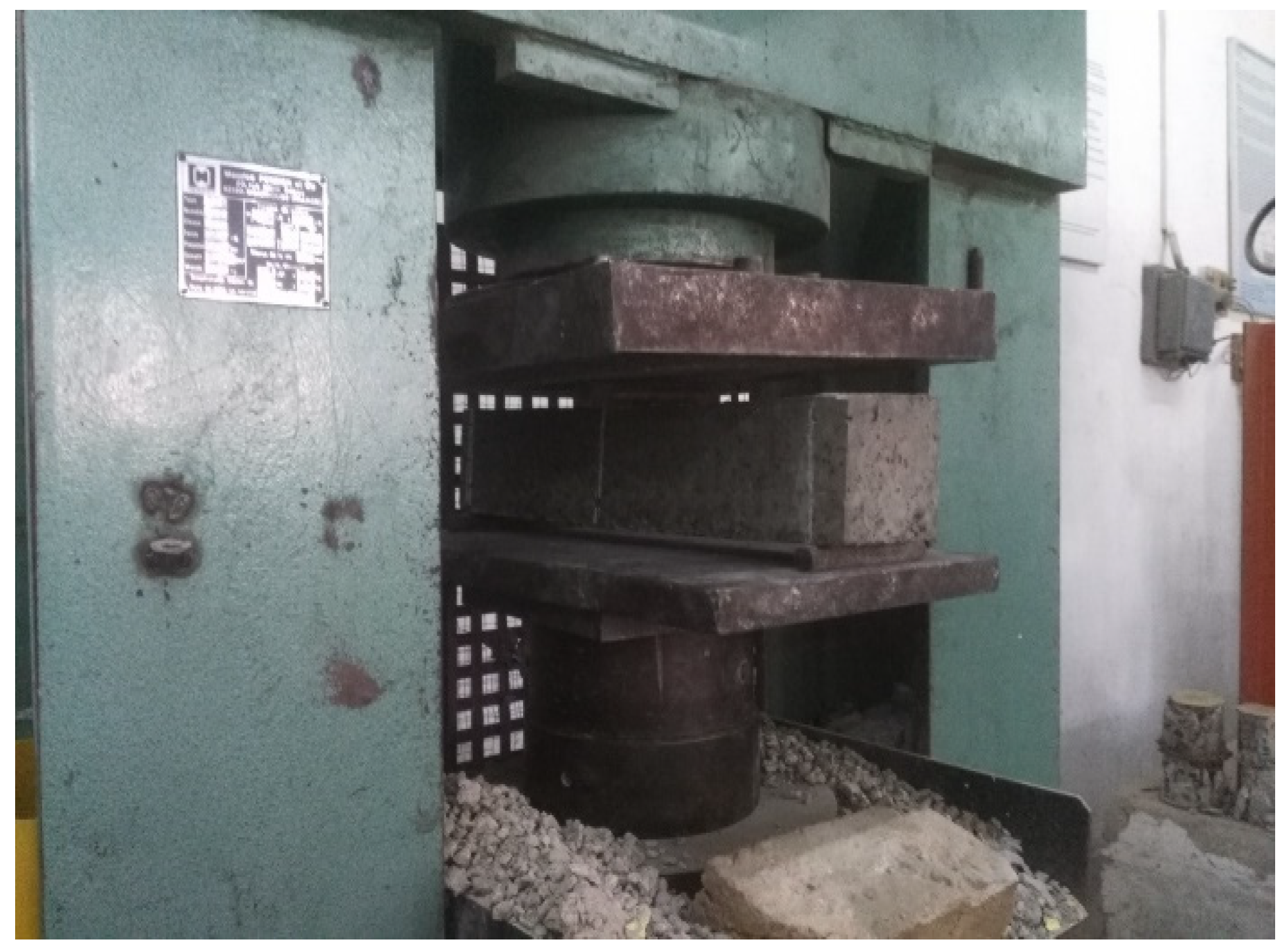
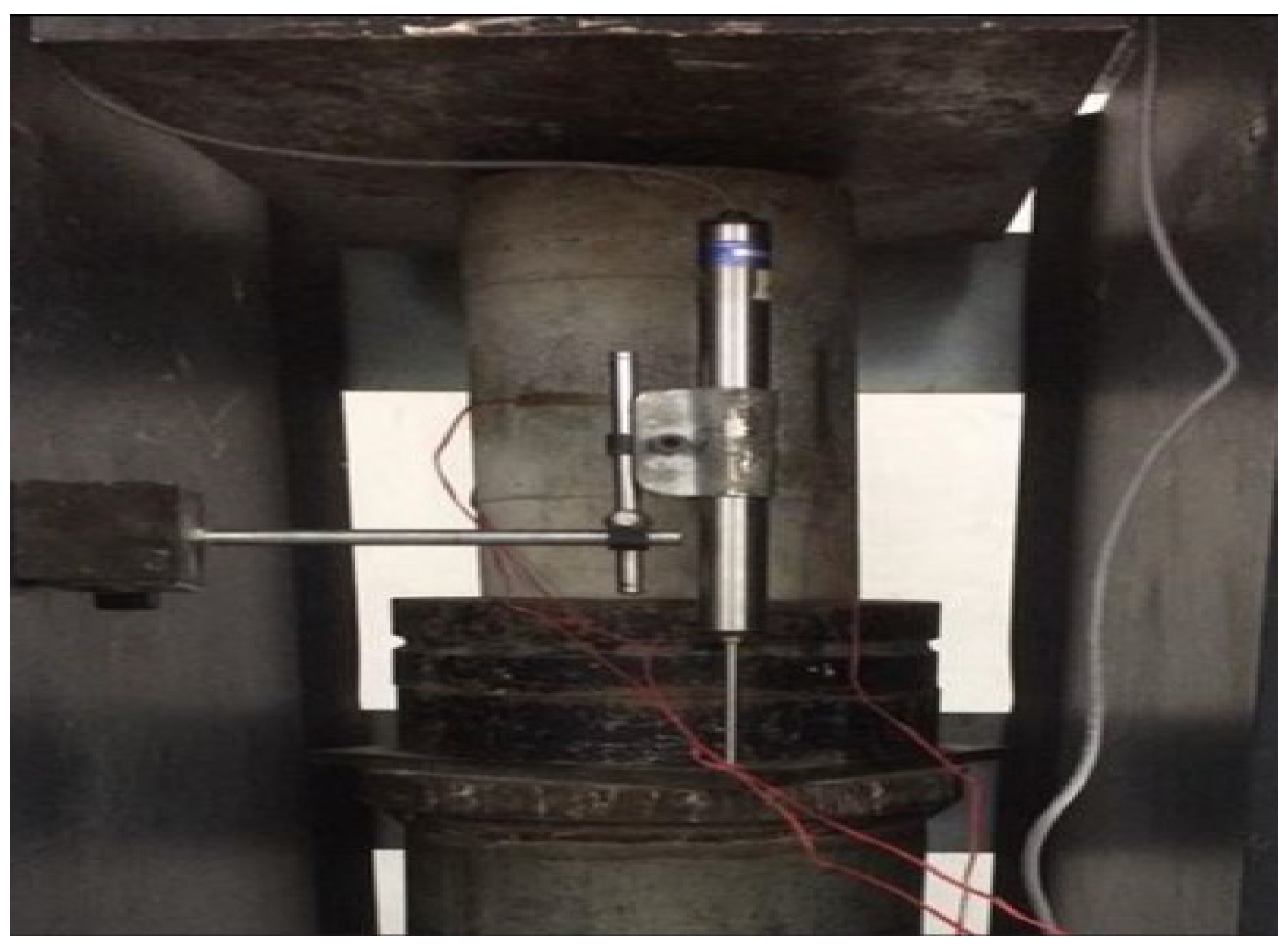


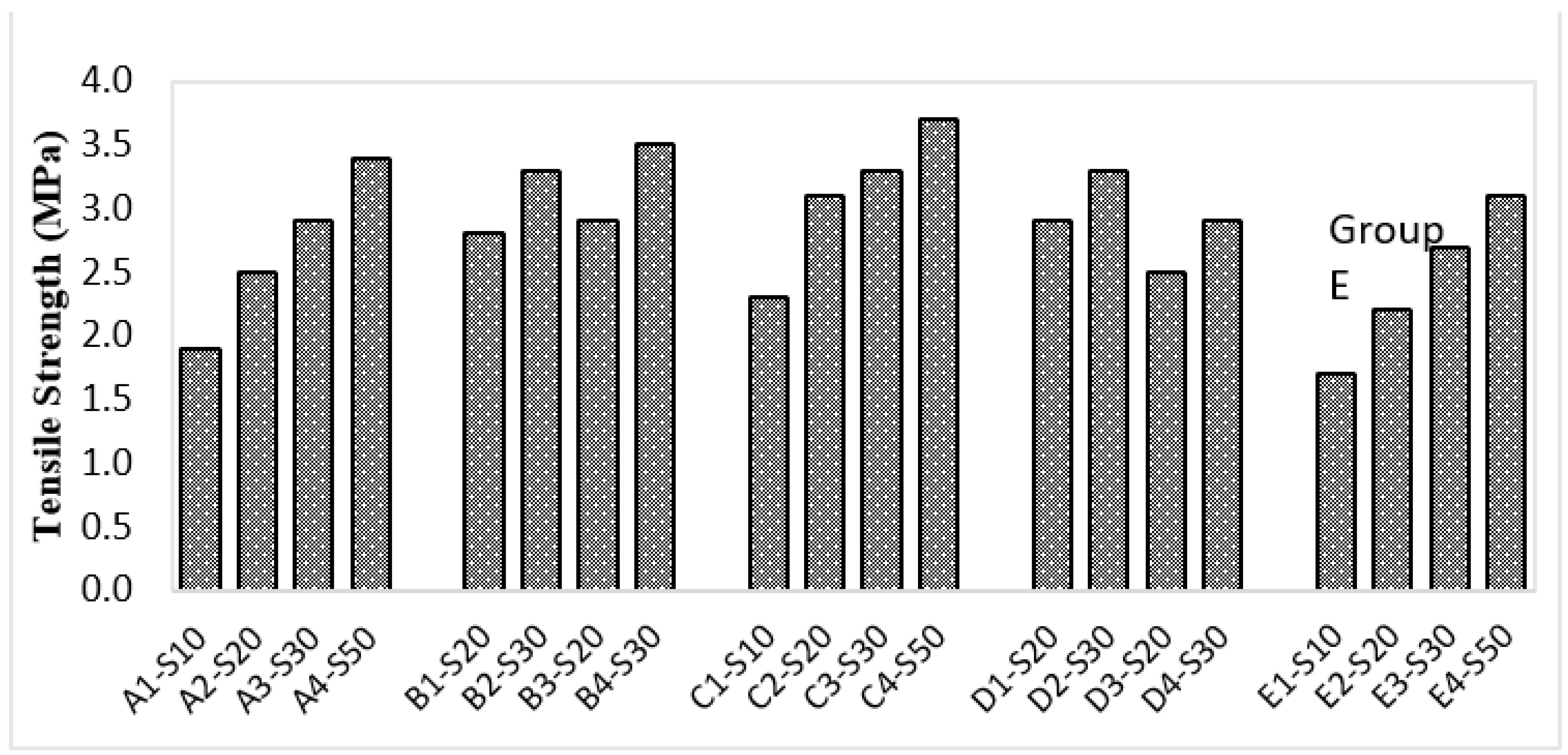
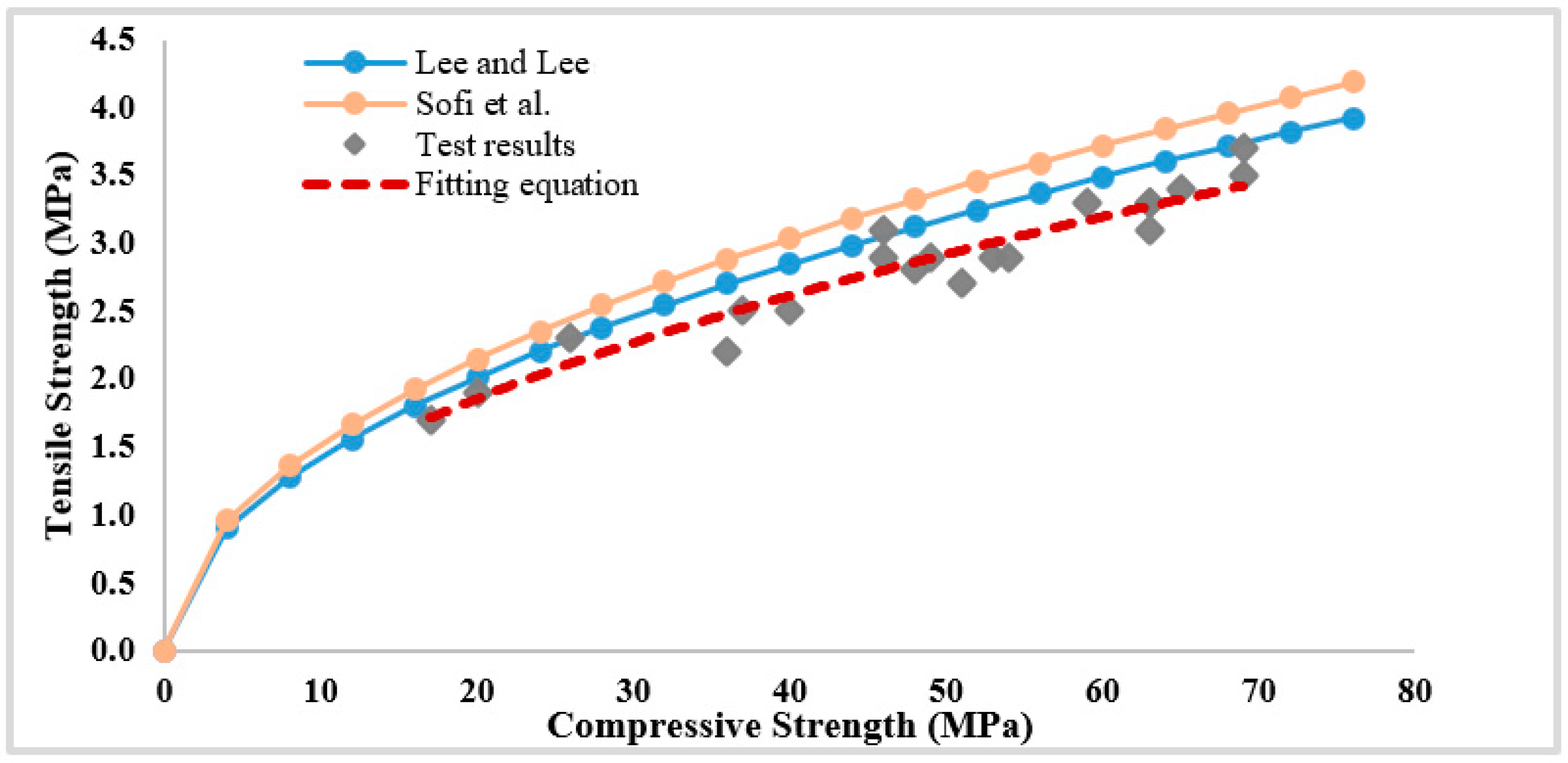
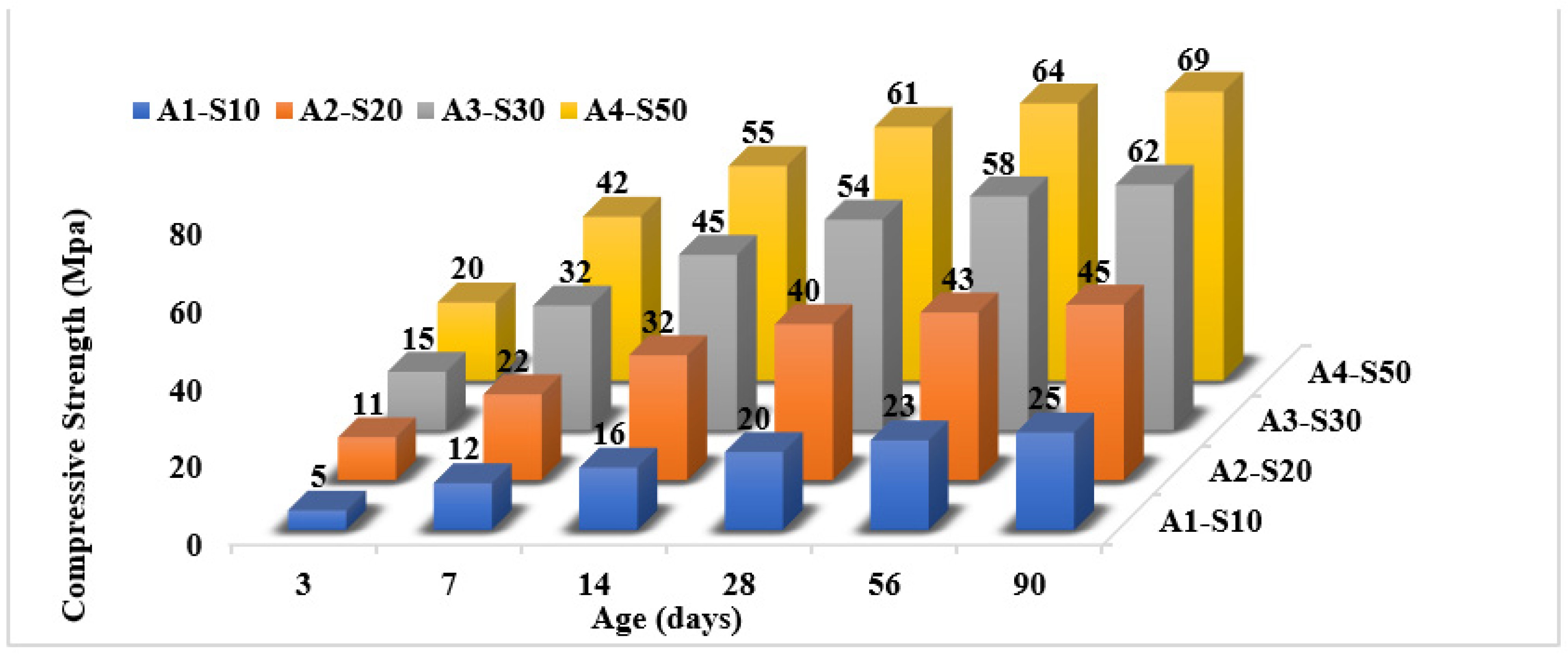
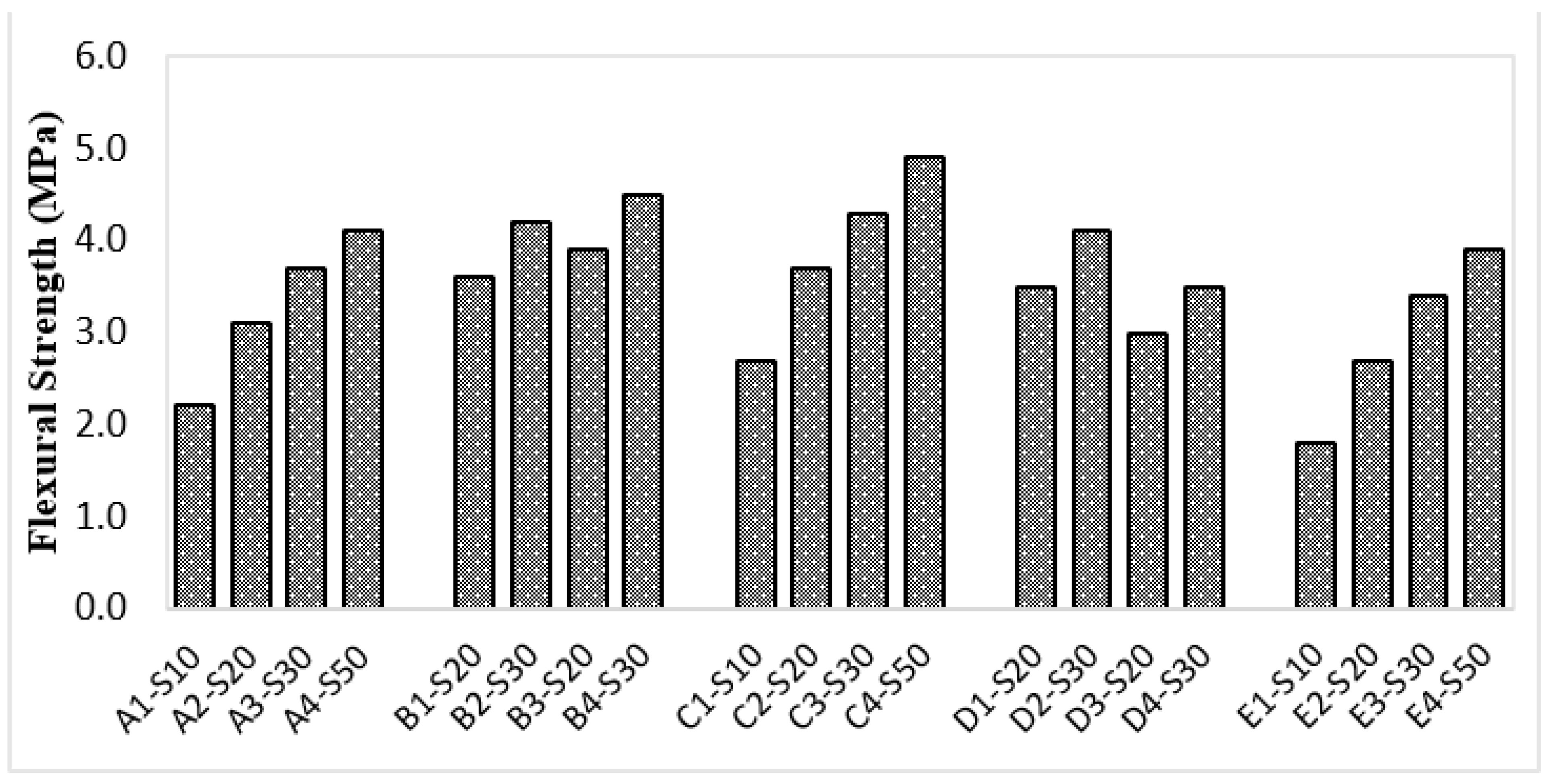

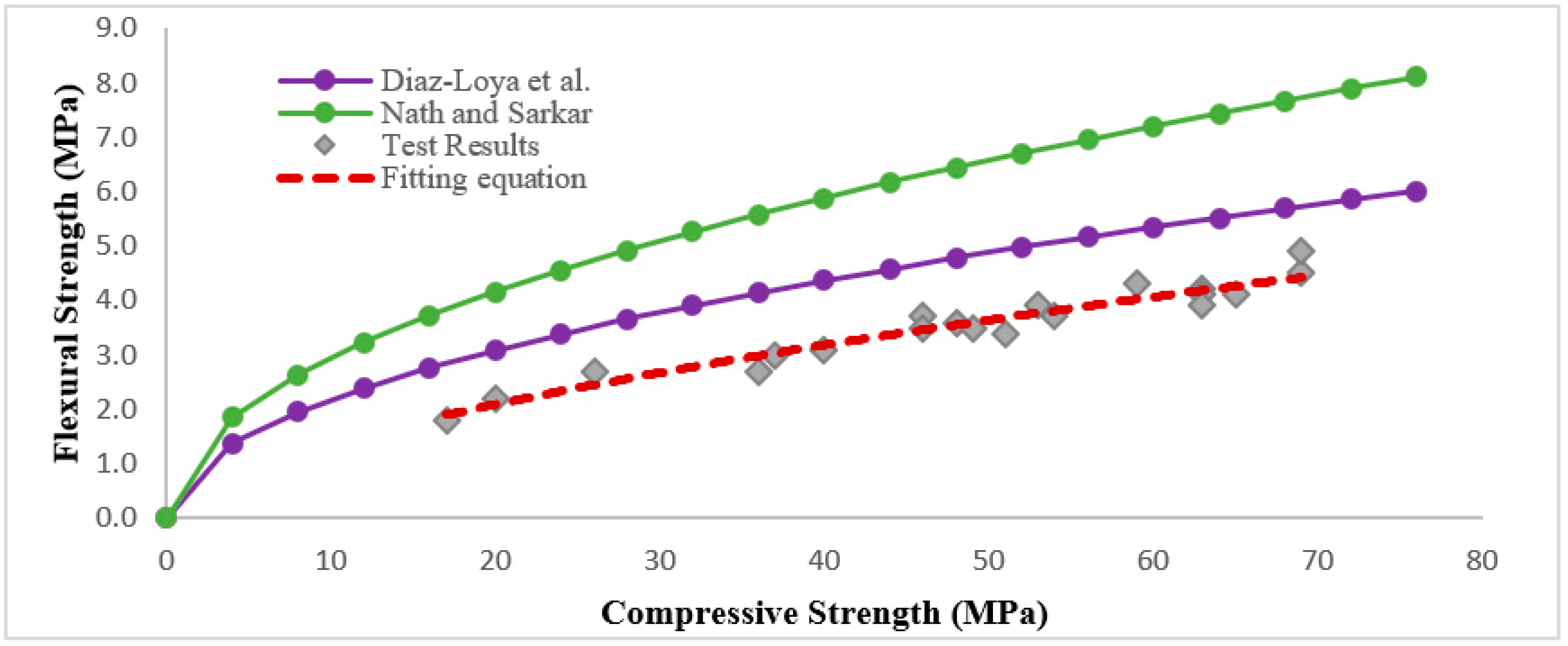
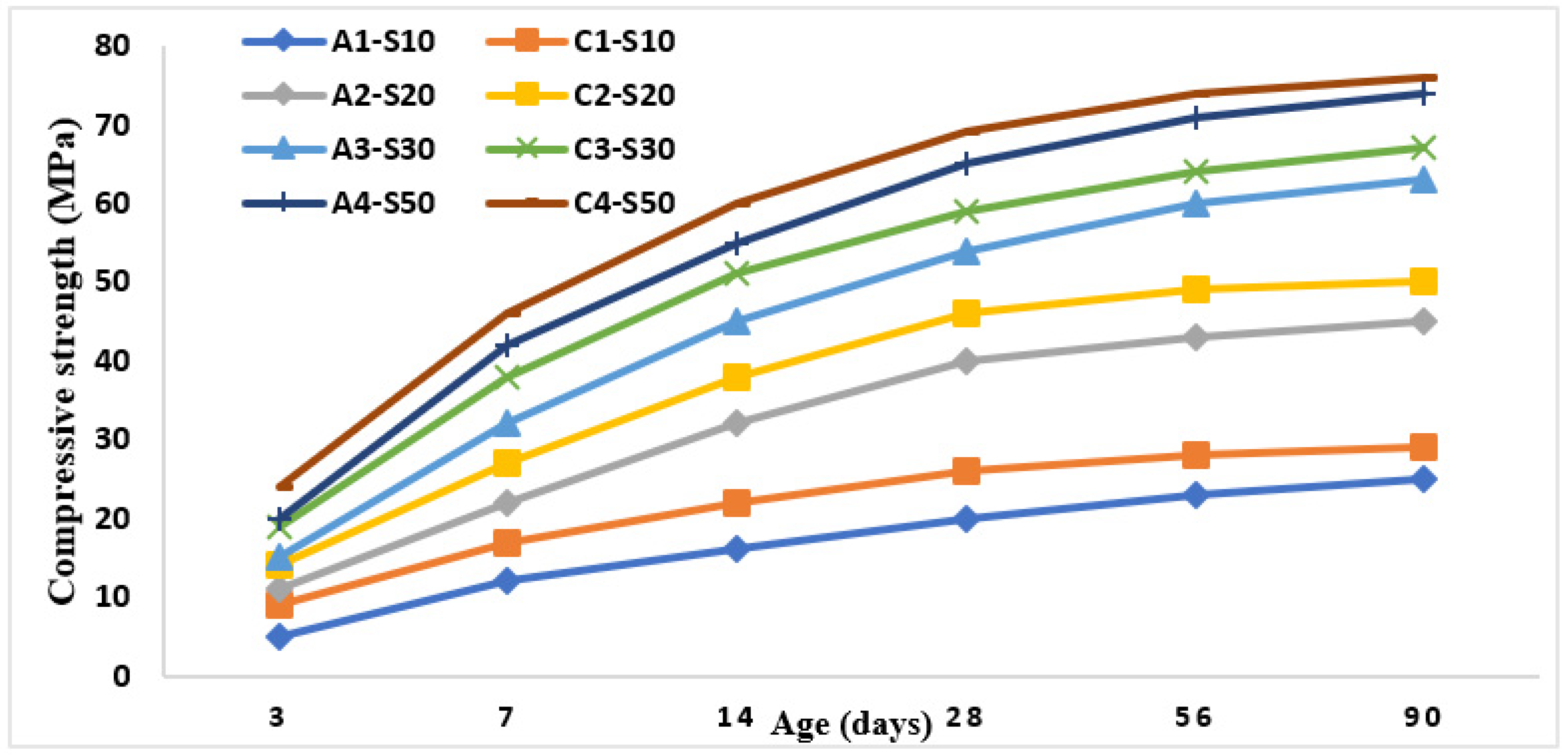


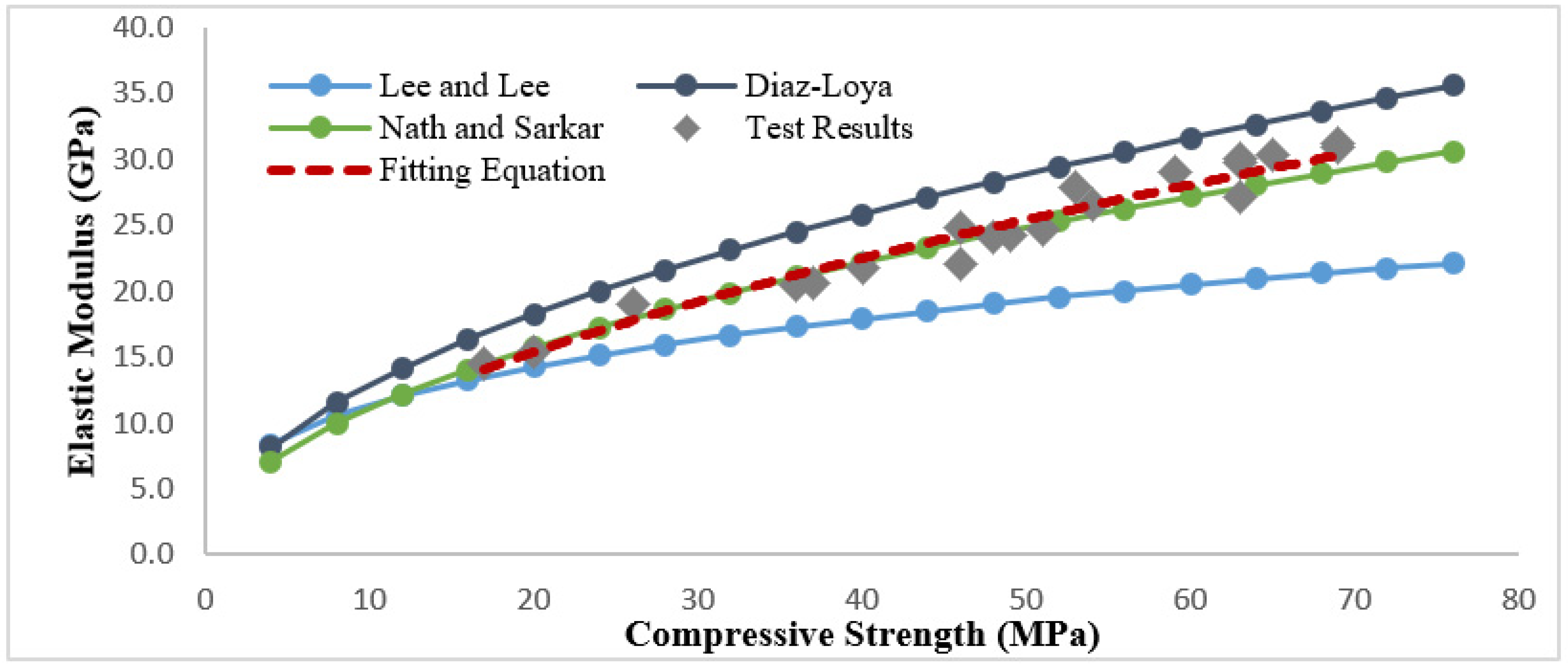
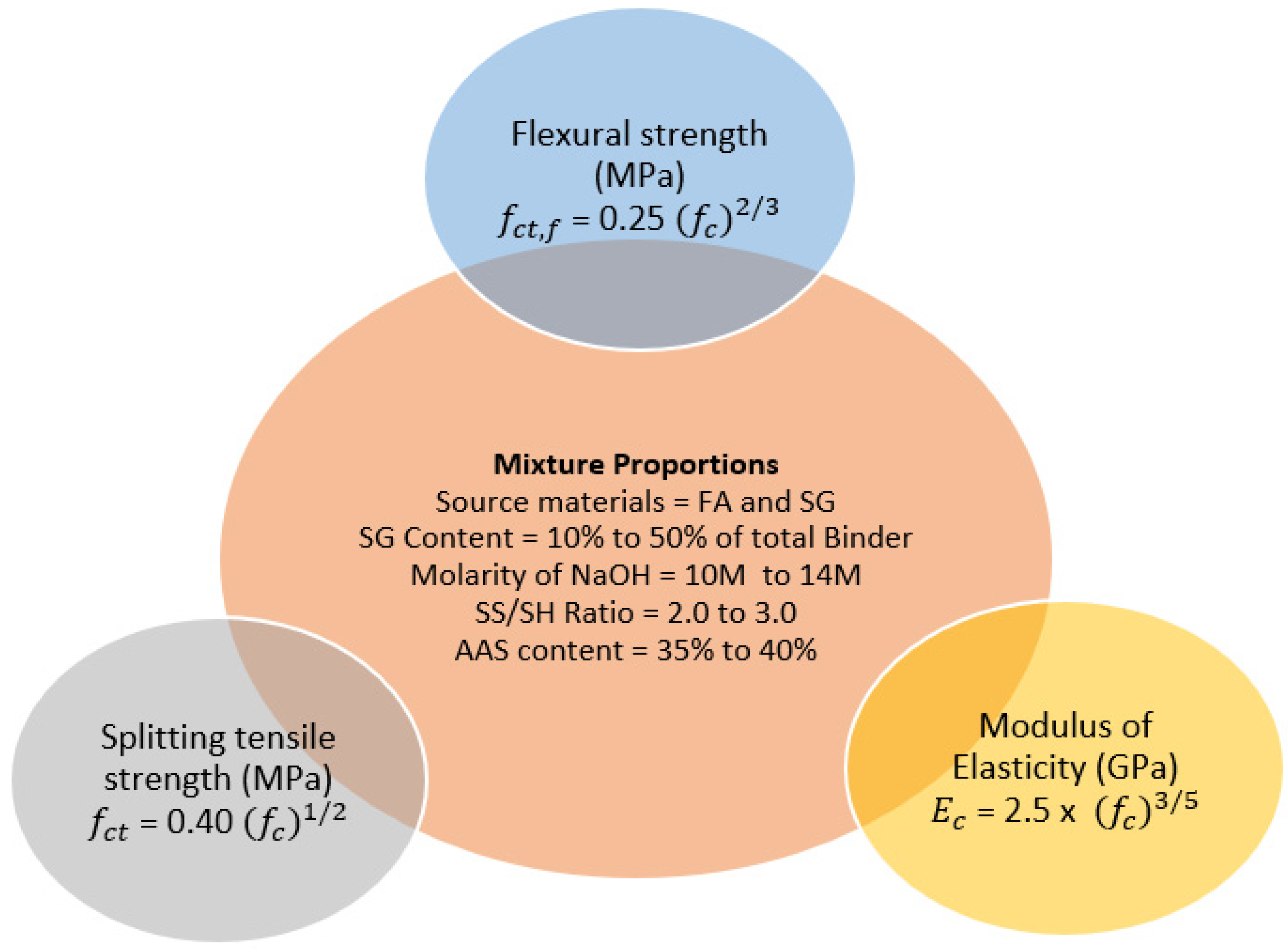
| Oxides | FA (%) | SG (%) |
|---|---|---|
| SiO2 | 54.55 | 34.2 |
| Al2O3 | 31.93 | 14.2 |
| Fe2O3 | 3.12 | 0.76 |
| Na2O | 0.25 | 0.3 |
| CaO | 4.65 | 44.95 |
| SO3 | 0.4 | 1.75 |
| K2O | 0.7 | 0.5 |
| P2O5 | 0.45 | 0.05 |
| MgO | 1.42 | 0.95 |
| TiO2 | 1.15 | 0.5 |
| LOI | 0.95 | 1.6 |
| Specific Surface Area (m2/kg) | 320.7 | 405 |
| Specific Gravity | 2.1 | 2.8 |
| Entity | Specification |
|---|---|
| Color | Colorless |
| Density, kg/m3 | 1460 |
| Total solid content | 48 (% mass) |
| Entity | Sand | CA |
|---|---|---|
| Relative Density | 2.64 | 2.70 |
| Bulk Density (kg/m3) | 1688.4 | 1644.5 |
| Fineness Modulus (kg/m3) | 2.50 | 7.65 |
| Water Absorption (% mass) | 1.40 | 1.20 |
| Group | Mix No. | Mix Proportions | Mix Quantities (kg/m3) | ||||||||||||
|---|---|---|---|---|---|---|---|---|---|---|---|---|---|---|---|
| Mix ID | SG:FA | AAS Content | SS/SH Ratio | M | Sand | CA | SG | FA | Total AAS | NaOH | Na2SiO3 | SP | Extra Water | ||
| A | 1 | A1-S10 | 10:90 | 40% | 2 | 10 | 640 | 1201 | 40 | 360 | 160 | 53 | 107 | 6 | - |
| 2 | A2-S20 | 20:80 | 40% | 2 | 10 | 643 | 1206 | 80 | 320 | 160 | 53 | 107 | 6 | - | |
| 3 | A3-S30 | 30:70 | 40% | 2 | 10 | 646 | 1212 | 120 | 280 | 160 | 53 | 107 | 6 | - | |
| 4 | A4-S50 | 50:50 | 40% | 2 | 10 | 652 | 1220 | 200 | 200 | 160 | 53 | 107 | 6 | - | |
| B | 5 | B1-S20 | 20:80 | 40% | 2 | 12 | 643 | 1206 | 80 | 320 | 160 | 53 | 107 | 6 | - |
| 6 | B2-S30 | 30:70 | 40% | 2 | 12 | 646 | 1212 | 120 | 280 | 160 | 53 | 107 | 6 | - | |
| 7 | B3-S20 | 20:80 | 40% | 2 | 14 | 644 | 1208 | 80 | 320 | 160 | 53 | 107 | 6 | - | |
| 8 | B4-S30 | 30:70 | 40% | 2 | 14 | 647 | 1214 | 120 | 280 | 160 | 53 | 107 | 6 | - | |
| C | 9 | C1-S10 | 10:90 | 35% | 2 | 10 | 644 | 1205 | 40 | 360 | 140 | 53 | 107 | 6 | - |
| 10 | C2-S20 | 20:80 | 35% | 2 | 10 | 646 | 1212 | 80 | 320 | 140 | 53 | 107 | 6 | - | |
| 11 | C3-S30 | 30:70 | 35% | 2 | 10 | 649 | 1216 | 120 | 280 | 140 | 53 | 107 | 6 | - | |
| 12 | C4-S50 | 50:50 | 35% | 2 | 10 | 655 | 1225 | 200 | 200 | 140 | 53 | 107 | 6 | - | |
| D | 13 | D1-S20 | 20:80 | 40% | 2.5 | 10 | 644 | 1208 | 80 | 320 | 160 | 46 | 114 | 6 | - |
| 14 | D2-S30 | 30:70 | 40% | 2.5 | 10 | 648 | 1215 | 120 | 280 | 160 | 46 | 114 | 6 | - | |
| 15 | D3-S20 | 20:80 | 40% | 3 | 10 | 645 | 1209 | 80 | 320 | 160 | 40 | 120 | 6 | - | |
| 16 | D4-S30 | 30:70 | 40% | 3 | 10 | 650 | 1218 | 120 | 280 | 160 | 40 | 120 | 6 | - | |
| E | 17 | E1-S10 | 10:90 | 35% | 2 | 10 | 644 | 1206 | 40 | 360 | 140 | 53 | 107 | 6 | 12 |
| 18 | E2-S20 | 20:80 | 35% | 2 | 10 | 646 | 1210 | 80 | 320 | 140 | 53 | 107 | 6 | 12 | |
| 19 | E3-S30 | 30:70 | 35% | 2 | 10 | 649 | 1216 | 120 | 280 | 140 | 53 | 107 | 6 | 12 | |
| 20 | E4-S50 | 50:50 | 35% | 2 | 10 | 655 | 1225 | 200 | 200 | 140 | 53 | 107 | 6 | 12 | |
| Group | Mix No. | Mix ID | Mix Proportions | Slump (mm) | Compressive Strength (MPa) | ||||||||
|---|---|---|---|---|---|---|---|---|---|---|---|---|---|
| SG: FA | Alkaline Content | SS/SH Ratio | M | 3 Day | 7 Days | 14 Days | 28 Days | 56 Days | 90 Days | ||||
| A | 1 | A1-S10 | 10:90 | 40% | 2 | 10 | 130 | 5 | 12 | 16 | 20 | 23 | 25 |
| 2 | A2-S20 | 20:80 | 40% | 2 | 10 | 120 | 11 | 22 | 32 | 40 | 43 | 45 | |
| 3 | A3-S30 | 30:70 | 40% | 2 | 10 | 100 | 15 | 32 | 45 | 54 | 58 | 62 | |
| 4 | A4-S50 | 50:50 | 40% | 2 | 10 | 90 | 20 | 42 | 55 | 61 | 64 | 69 | |
| B | 5 | B1-S20 | 20:80 | 40% | 2 | 12 | 80 | 15 | 29 | 40 | 48 | 52 | 54 |
| 6 | B2-S30 | 30:70 | 40% | 2 | 12 | 45 | 20 | 38 | 54 | 63 | 67 | 69 | |
| 7 | B3-S20 | 20:80 | 40% | 2 | 14 | 60 | 18 | 33 | 44 | 53 | 58 | 59 | |
| 8 | B4-S30 | 30:70 | 40% | 2 | 14 | 30 | 24 | 43 | 57 | 61 | 66 | 69 | |
| C | 9 | C1-S10 | 10:90 | 35% | 2 | 10 | 70 | 9 | 17 | 22 | 26 | 28 | 29 |
| 10 | C2-S20 | 20:80 | 35% | 2 | 10 | 60 | 14 | 27 | 38 | 46 | 49 | 50 | |
| 11 | C3-S30 | 30:70 | 35% | 2 | 10 | 45 | 19 | 38 | 51 | 59 | 64 | 67 | |
| 12 | C4-S50 | 50:50 | 35% | 2 | 10 | 35 | 24 | 46 | 60 | 69 | 74 | 76 | |
| D | 13 | D1-S20 | 20:80 | 40% | 2.5 | 10 | 110 | 13 | 26 | 37 | 46 | 49 | 50 |
| 14 | D2-S30 | 30:70 | 40% | 2.5 | 10 | 85 | 18 | 38 | 52 | 63 | 68 | 70 | |
| 15 | D3-S20 | 20:80 | 40% | 3 | 10 | 75 | 10 | 21 | 30 | 37 | 41 | 42 | |
| 16 | D4-S30 | 30:70 | 40% | 3 | 10 | 60 | 14 | 30 | 42 | 49 | 54 | 55 | |
| E | 17 | E1-S10 | 10:90 | 35% | 2 | 10 | 150 | 5 | 10 | 14 | 17 | 19 | 20 |
| 18 | E2-S20 | 20:80 | 35% | 2 | 10 | 135 | 11 | 21 | 30 | 36 | 39 | 41 | |
| 19 | E3-S30 | 30:70 | 35% | 2 | 10 | 115 | 17 | 32 | 43 | 51 | 56 | 59 | |
| 20 | E4-S50 | 50:50 | 35% | 2 | 10 | 100 | 22 | 41 | 54 | 63 | 67 | 69 | |
| Mix ID | Compressive Strength, (MPa) | Tensile Strength, (MPa) | ||||
|---|---|---|---|---|---|---|
| Test | Lee & Lee | Sofi et al. | Test/Lee & Lee | Test/Sofi et al. | ||
| A1-S10 | 20.0 | 1.9 | 2.0 | 2.1 | 0.94 | 0.89 |
| A2-S20 | 40.0 | 2.5 | 2.8 | 3.0 | 0.88 | 0.82 |
| A3-S30 | 54.0 | 2.9 | 3.3 | 3.5 | 0.88 | 0.82 |
| A4-S50 | 65.0 | 3.4 | 3.6 | 3.9 | 0.94 | 0.88 |
| B1-S20 | 48.0 | 2.8 | 3.1 | 3.3 | 0.90 | 0.84 |
| B2-S30 | 63.0 | 3.3 | 3.6 | 3.8 | 0.92 | 0.87 |
| B3-S20 | 53.0 | 2.9 | 3.3 | 3.5 | 0.89 | 0.83 |
| B4-S30 | 69.0 | 3.5 | 3.7 | 4.0 | 0.94 | 0.88 |
| C1-S10 | 26.0 | 2.3 | 2.3 | 2.4 | 1.00 | 0.94 |
| C2-S20 | 46.0 | 3.1 | 3.1 | 3.3 | 1.02 | 0.95 |
| C3-S30 | 59.0 | 3.3 | 3.5 | 3.7 | 0.95 | 0.90 |
| C4-S50 | 69.0 | 3.7 | 3.7 | 4.0 | 0.99 | 0.93 |
| D1-S20 | 46.0 | 2.9 | 3.1 | 3.3 | 0.95 | 0.89 |
| D2-S30 | 63.0 | 3.3 | 3.6 | 3.8 | 0.92 | 0.87 |
| D3-S20 | 37.0 | 2.5 | 2.7 | 2.9 | 0.91 | 0.86 |
| D4-S30 | 49.0 | 2.9 | 3.2 | 3.4 | 0.92 | 0.86 |
| E1-S10 | 17.0 | 1.7 | 1.9 | 2.0 | 0.92 | 0.86 |
| E2-S20 | 36.0 | 2.2 | 2.7 | 2.9 | 0.81 | 0.76 |
| E3-S30 | 51.0 | 2.7 | 3.2 | 3.4 | 0.84 | 0.79 |
| E4-S50 | 63.0 | 3.1 | 3.6 | 3.8 | 0.87 | 0.81 |
| Mix ID | Compressive Strength, (MPa) | Flexural Strength, (MPa) | ||||
|---|---|---|---|---|---|---|
| Test | Diaz-Loya et al. | Nath and Sarkar | Test/Diaz-Loya et al. | Test/Nath and Sarkar | ||
| A1-S10 | 20.0 | 2.2 | 3.1 | 4.2 | 0.71 | 0.53 |
| A2-S20 | 40.0 | 3.1 | 4.4 | 5.9 | 0.71 | 0.53 |
| A3-S30 | 54.0 | 3.7 | 5.1 | 6.8 | 0.73 | 0.54 |
| A4-S50 | 65.0 | 4.1 | 5.6 | 7.5 | 0.74 | 0.55 |
| B1-S20 | 48.0 | 3.6 | 4.8 | 6.4 | 0.75 | 0.56 |
| B2-S30 | 63.0 | 4.2 | 5.5 | 7.4 | 0.77 | 0.57 |
| B3-S20 | 53.0 | 3.9 | 5.0 | 6.8 | 0.78 | 0.58 |
| B4-S30 | 69.0 | 4.5 | 5.7 | 7.7 | 0.79 | 0.58 |
| C1-S10 | 26.0 | 2.7 | 3.5 | 4.7 | 0.77 | 0.57 |
| C2-S20 | 46.0 | 3.7 | 4.7 | 6.3 | 0.79 | 0.59 |
| C3-S30 | 59.0 | 4.3 | 5.3 | 7.1 | 0.81 | 0.60 |
| C4-S50 | 69.0 | 4.9 | 5.7 | 7.7 | 0.85 | 0.63 |
| D1-S20 | 46.0 | 3.5 | 4.7 | 6.3 | 0.75 | 0.55 |
| D2-S30 | 63.0 | 4.1 | 5.5 | 7.4 | 0.75 | 0.56 |
| D3-S20 | 37.0 | 3.0 | 4.2 | 5.7 | 0.71 | 0.53 |
| D4-S30 | 49.0 | 3.5 | 4.8 | 6.5 | 0.72 | 0.54 |
| E1-S10 | 17.0 | 1.8 | 2.8 | 3.8 | 0.63 | 0.47 |
| E2-S20 | 36.0 | 2.7 | 4.1 | 5.6 | 0.65 | 0.48 |
| E3-S30 | 51.0 | 3.4 | 4.9 | 6.6 | 0.69 | 0.51 |
| E4-S50 | 63.0 | 3.9 | 5.5 | 7.4 | 0.71 | 0.53 |
| Mix ID | Compressive Strength, (MPa) | Elastic Modulus, (GPa) | ||||||
|---|---|---|---|---|---|---|---|---|
| Test | Lee & Lee | Diaz-Loya | Nath & Sarkar | Test/Lee & Lee | Test/Diaz-Loya | Test/Nath & Sarkar | ||
| A1-S10 | 20.0 | 15.4 | 14.2 | 18.8 | 15.7 | 1.08 | 0.82 | 0.98 |
| A2-S20 | 40.0 | 21.8 | 17.9 | 26.7 | 22.2 | 1.22 | 0.82 | 0.98 |
| A3-S30 | 54.0 | 26.6 | 19.8 | 31.2 | 25.8 | 1.35 | 0.85 | 1.03 |
| A4-S50 | 65.0 | 30.3 | 21.0 | 34.8 | 28.3 | 1.44 | 0.87 | 1.07 |
| B1-S20 | 48.0 | 24.1 | 19.0 | 29.4 | 24.3 | 1.27 | 0.82 | 0.99 |
| B2-S30 | 63.0 | 30.1 | 20.8 | 33.8 | 27.9 | 1.45 | 0.89 | 1.08 |
| B3-S20 | 53.0 | 27.8 | 19.6 | 30.9 | 25.6 | 1.42 | 0.90 | 1.09 |
| B4-S30 | 69.0 | 31.2 | 21.4 | 35.5 | 29.2 | 1.46 | 0.88 | 1.07 |
| C1-S10 | 26.0 | 19.0 | 15.5 | 21.3 | 17.9 | 1.22 | 0.89 | 1.06 |
| C2-S20 | 46.0 | 24.8 | 18.7 | 28.4 | 23.8 | 1.32 | 0.87 | 1.04 |
| C3-S30 | 59.0 | 29.0 | 20.4 | 32.2 | 27.0 | 1.42 | 0.90 | 1.08 |
| C4-S50 | 69.0 | 30.9 | 21.4 | 35.1 | 29.2 | 1.44 | 0.88 | 1.06 |
| D1-S20 | 46.0 | 22.1 | 18.7 | 28.8 | 23.8 | 1.18 | 0.77 | 0.93 |
| D2-S30 | 63.0 | 27.2 | 20.8 | 33.8 | 27.9 | 1.31 | 0.80 | 0.98 |
| D3-S20 | 37.0 | 20.6 | 17.4 | 26.0 | 21.4 | 1.18 | 0.79 | 0.96 |
| D4-S30 | 49.0 | 24.2 | 19.1 | 30.2 | 24.6 | 1.26 | 0.80 | 0.98 |
| E1-S10 | 17.0 | 14.5 | 13.5 | 17.0 | 14.5 | 1.07 | 0.85 | 1.00 |
| E2-S20 | 36.0 | 20.4 | 17.3 | 24.9 | 21.1 | 1.18 | 0.82 | 0.97 |
| E3-S30 | 51.0 | 24.6 | 19.4 | 29.7 | 25.1 | 1.27 | 0.83 | 0.98 |
| E4-S50 | 63.0 | 29.8 | 20.8 | 33.2 | 27.9 | 1.43 | 0.90 | 1.07 |
Publisher’s Note: MDPI stays neutral with regard to jurisdictional claims in published maps and institutional affiliations. |
© 2021 by the authors. Licensee MDPI, Basel, Switzerland. This article is an open access article distributed under the terms and conditions of the Creative Commons Attribution (CC BY) license (https://creativecommons.org/licenses/by/4.0/).
Share and Cite
Waqas, R.M.; Butt, F.; Zhu, X.; Jiang, T.; Tufail, R.F. A Comprehensive Study on the Factors Affecting the Workability and Mechanical Properties of Ambient Cured Fly Ash and Slag Based Geopolymer Concrete. Appl. Sci. 2021, 11, 8722. https://doi.org/10.3390/app11188722
Waqas RM, Butt F, Zhu X, Jiang T, Tufail RF. A Comprehensive Study on the Factors Affecting the Workability and Mechanical Properties of Ambient Cured Fly Ash and Slag Based Geopolymer Concrete. Applied Sciences. 2021; 11(18):8722. https://doi.org/10.3390/app11188722
Chicago/Turabian StyleWaqas, Rana Muhammad, Faheem Butt, Xulong Zhu, Tianshui Jiang, and Rana Faisal Tufail. 2021. "A Comprehensive Study on the Factors Affecting the Workability and Mechanical Properties of Ambient Cured Fly Ash and Slag Based Geopolymer Concrete" Applied Sciences 11, no. 18: 8722. https://doi.org/10.3390/app11188722
APA StyleWaqas, R. M., Butt, F., Zhu, X., Jiang, T., & Tufail, R. F. (2021). A Comprehensive Study on the Factors Affecting the Workability and Mechanical Properties of Ambient Cured Fly Ash and Slag Based Geopolymer Concrete. Applied Sciences, 11(18), 8722. https://doi.org/10.3390/app11188722






